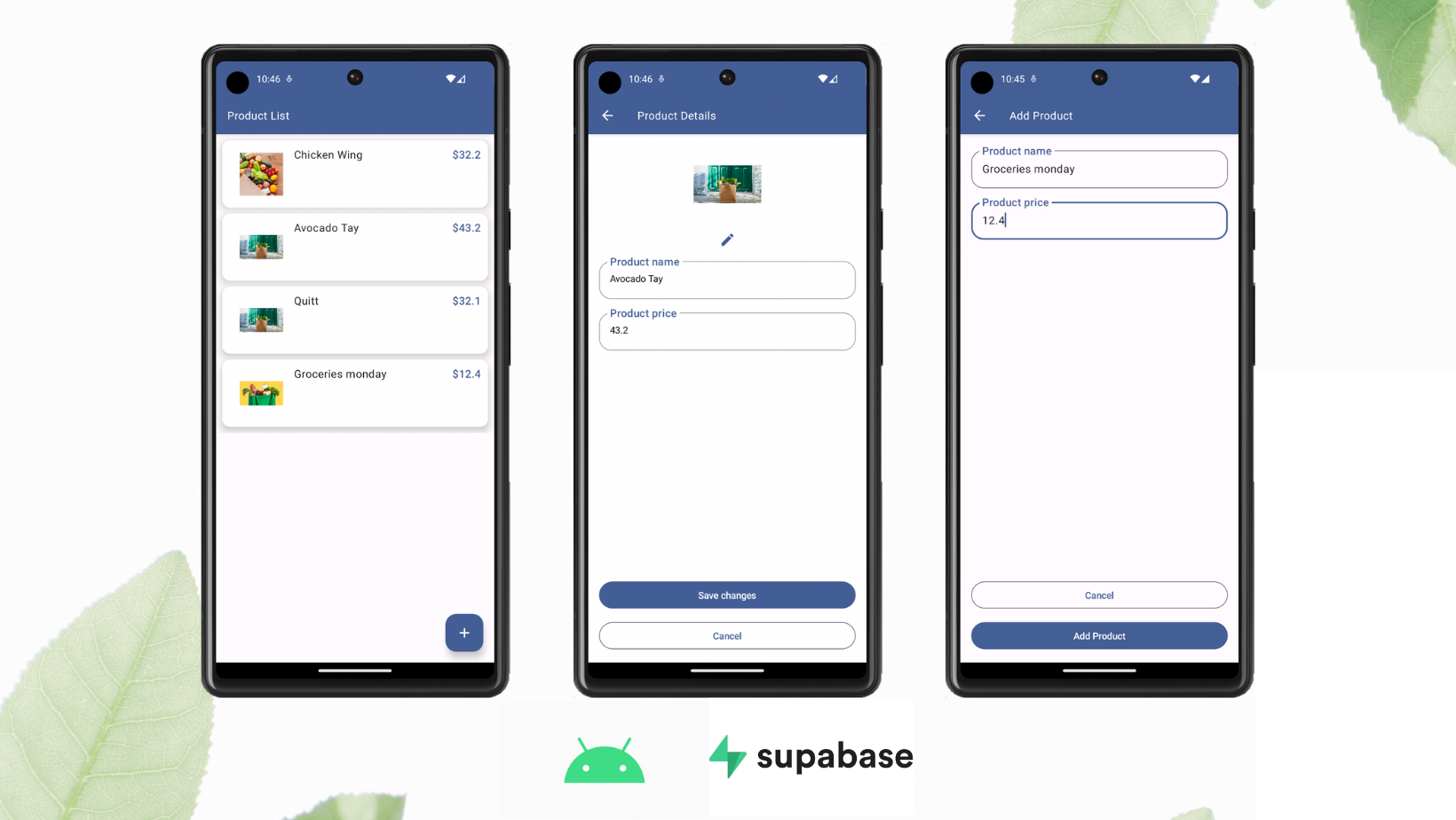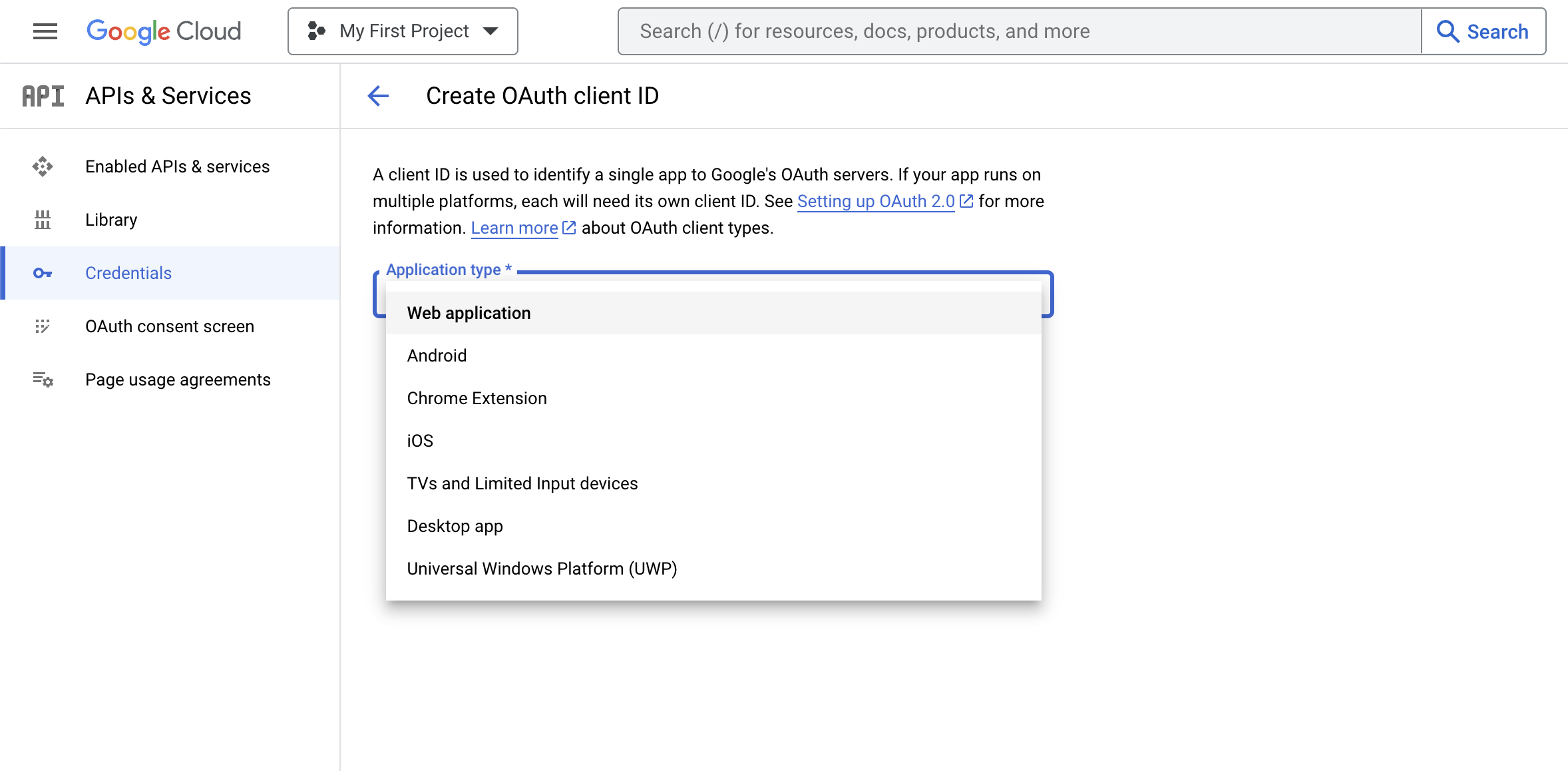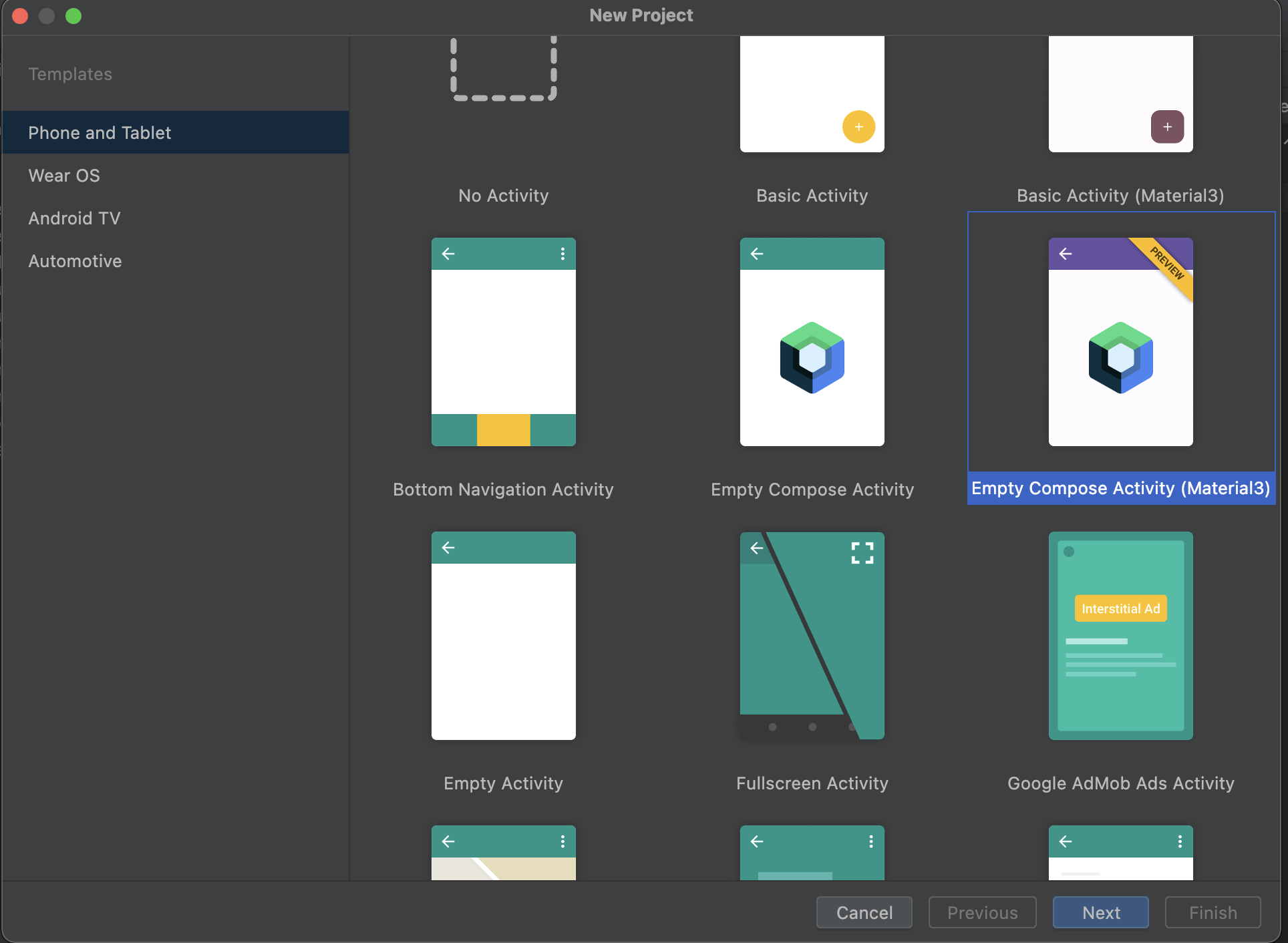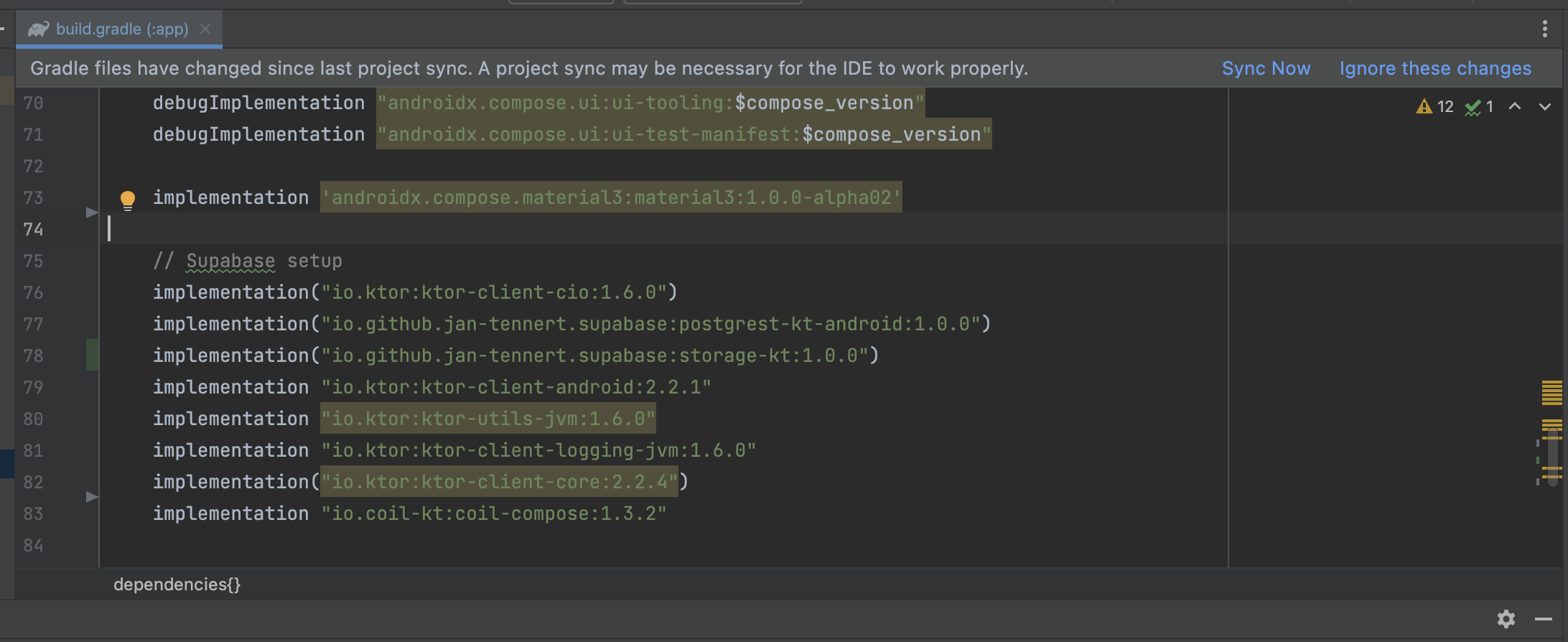Build a Product Management Android App with Jetpack Compose
This tutorial demonstrates how to build a basic product management app. The app demonstrates management operations, photo upload, account creation and authentication using:
- Supabase Database - a Postgres database for storing your user data and Row Level Security so data is protected and users can only access their own information.
- Supabase Auth - users log in through magic links sent to their email (without having to set up a password).
- Supabase Storage - users can upload a profile photo.

If you get stuck while working through this guide, refer to the full example on GitHub.
Project setup
Before we start building we're going to set up our Database and API. This is as simple as starting a new Project in Supabase and then creating a "schema" inside the database.
Create a project
- Create a new project in the Supabase Dashboard.
- Enter your project details.
- Wait for the new database to launch.
Set up the database schema
Now we are going to set up the database schema. You can just copy/paste the SQL from below and run it yourself.
_32-- Create a table for public profiles_32_32create table_32 public.products (_32 id uuid not null default gen_random_uuid (),_32 name text not null,_32 price real not null,_32 image text null,_32 constraint products_pkey primary key (id)_32 ) tablespace pg_default;_32_32-- Set up Storage!_32insert into storage.buckets (id, name)_32 values ('Product Image', 'Product Image');_32_32-- Set up access controls for storage._32-- See https://supabase.com/docs/guides/storage/security/access-control#policy-examples for more details._32CREATE POLICY "Enable read access for all users" ON "storage"."objects"_32AS PERMISSIVE FOR SELECT_32TO public_32USING (true)_32_32CREATE POLICY "Enable insert for all users" ON "storage"."objects"_32AS PERMISSIVE FOR INSERT_32TO authenticated, anon_32WITH CHECK (true)_32_32CREATE POLICY "Enable update for all users" ON "storage"."objects"_32AS PERMISSIVE FOR UPDATE_32TO public_32USING (true)_32WITH CHECK (true)
Get the API Keys
Now that you've created some database tables, you are ready to insert data using the auto-generated API.
We just need to get the Project URL and anon key from the API settings.
- Go to the API Settings page in the Dashboard.
- Find your Project
URL,anon, andservice_rolekeys on this page.
Set up Google Authentication
From the Google Console, create a new project and add OAuth2 credentials.

In your Supabase Auth settings enable Google as a provider and set the required credentials as outlined in the auth docs.
Building the app
Create new Android project
Open Android Studio > New Project > Base Activity (Jetpack Compose).

Set up API key and secret securely
Create local environment secret
Create or edit the local.properties file at the root (same level as build.gradle) of your project.
Note: Do not commit this file to your source control, for example, by adding it to your
.gitignorefile!
_10SUPABASE_ANON_KEY=YOUR_SUPABASE_ANON_KEY_10SUPABASE_URL=YOUR_SUPABASE_URL
Read and set value to BuildConfig
In your build.gradle (app) file, create a Properties object and read the values from your local.properties file by calling the buildConfigField method:
_15defaultConfig {_15 applicationId "com.example.manageproducts"_15 minSdkVersion 22_15 targetSdkVersion 33_15 versionCode 5_15 versionName "1.0"_15 testInstrumentationRunner "androidx.test.runner.AndroidJUnitRunner"_15_15 // Set value part_15 Properties properties = new Properties()_15 properties.load(project.rootProject.file("local.properties").newDataInputStream())_15 buildConfigField("String", "SUPABASE_ANON_KEY", "\"${properties.getProperty("SUPABASE_ANON_KEY")}\"")_15 buildConfigField("String", "SECRET", "\"${properties.getProperty("SECRET")}\"")_15 buildConfigField("String", "SUPABASE_URL", "\"${properties.getProperty("SUPABASE_URL")}\"")_15}
Use value from BuildConfig
Read the value from BuildConfig:
_10val url = BuildConfig.SUPABASE_URL_10val apiKey = BuildConfig.SUPABASE_ANON_KEY
Set up Supabase dependencies

In the build.gradle (app) file, add these dependencies then press "Sync now." Replace the dependency version placeholders $supabase_version and $ktor_version with their respective latest versions.
_10implementation "io.github.jan-tennert.supabase:postgrest-kt:$supabase_version"_10implementation "io.github.jan-tennert.supabase:storage-kt:$supabase_version"_10implementation "io.github.jan-tennert.supabase:gotrue-kt:$supabase_version"_10implementation "io.ktor:ktor-client-android:$ktor_version"_10implementation "io.ktor:ktor-client-core:$ktor_version"_10implementation "io.ktor:ktor-utils:$ktor_version"
Also in the build.gradle (app) file, add the plugin for serialization. The version of this plugin should be the same as your Kotlin version.
_10plugins {_10 ..._10 id 'org.jetbrains.kotlin.plugin.serialization' version '$kotlin_version'_10 ..._10}
Set up Hilt for dependency injection
In the build.gradle (app) file, add the following:
_10implementation "com.google.dagger:hilt-android:$hilt_version"_10annotationProcessor "com.google.dagger:hilt-compiler:$hilt_version"_10implementation("androidx.hilt:hilt-navigation-compose:1.0.0")
Create a new ManageProductApplication.kt class extending Application with @HiltAndroidApp annotation:
_10// ManageProductApplication.kt_10@HiltAndroidApp_10class ManageProductApplication: Application()
Open the AndroidManifest.xml file, update name property of Application tag:
_10<application_10..._10 android:name=".ManageProductApplication"_10..._10</application>
Create the MainActivity:
_10@AndroidEntryPoint_10class MainActivity : ComponentActivity() {_10 //This will come later_10}
Provide Supabase instances with Hilt
To make the app easier to test, create a SupabaseModule.kt file as follows:
_41@InstallIn(SingletonComponent::class)_41@Module_41object SupabaseModule {_41_41 @Provides_41 @Singleton_41 fun provideSupabaseClient(): SupabaseClient {_41 return createSupabaseClient(_41 supabaseUrl = BuildConfig.SUPABASE_URL,_41 supabaseKey = BuildConfig.SUPABASE_ANON_KEY_41 ) {_41 install(Postgrest)_41 install(Auth) {_41 flowType = FlowType.PKCE_41 scheme = "app"_41 host = "supabase.com"_41 }_41 install(Storage)_41 }_41 }_41_41 @Provides_41 @Singleton_41 fun provideSupabaseDatabase(client: SupabaseClient): Postgrest {_41 return client.postgrest_41 }_41_41 @Provides_41 @Singleton_41 fun provideSupabaseAuth(client: SupabaseClient): Auth {_41 return client.auth_41 }_41_41_41 @Provides_41 @Singleton_41 fun provideSupabaseStorage(client: SupabaseClient): Storage {_41 return client.storage_41 }_41_41}
Create a data transfer object
Create a ProductDto.kt class and use annotations to parse data from Supabase:
_15@Serializable_15data class ProductDto(_15_15 @SerialName("name")_15 val name: String,_15_15 @SerialName("price")_15 val price: Double,_15_15 @SerialName("image")_15 val image: String?,_15_15 @SerialName("id")_15 val id: String,_15)
Create a Domain object in Product.kt expose the data in your view:
_10data class Product(_10 val id: String,_10 val name: String,_10 val price: Double,_10 val image: String?_10)
Implement repositories
Create a ProductRepository interface and its implementation named ProductRepositoryImpl. This holds the logic to interact with data sources from Supabase. Do the same with the AuthenticationRepository.
Create the Product Repository:
_10interface ProductRepository {_10 suspend fun createProduct(product: Product): Boolean_10 suspend fun getProducts(): List<ProductDto>?_10 suspend fun getProduct(id: String): ProductDto_10 suspend fun deleteProduct(id: String)_10 suspend fun updateProduct(_10 id: String, name: String, price: Double, imageName: String, imageFile: ByteArray_10 )_10}
_91class ProductRepositoryImpl @Inject constructor(_91 private val postgrest: Postgrest,_91 private val storage: Storage,_91) : ProductRepository {_91 override suspend fun createProduct(product: Product): Boolean {_91 return try {_91 withContext(Dispatchers.IO) {_91 val productDto = ProductDto(_91 name = product.name,_91 price = product.price,_91 )_91 postgrest.from("products").insert(productDto)_91 true_91 }_91 true_91 } catch (e: java.lang.Exception) {_91 throw e_91 }_91 }_91_91 override suspend fun getProducts(): List<ProductDto>? {_91 return withContext(Dispatchers.IO) {_91 val result = postgrest.from("products")_91 .select().decodeList<ProductDto>()_91 result_91 }_91 }_91_91_91 override suspend fun getProduct(id: String): ProductDto {_91 return withContext(Dispatchers.IO) {_91 postgrest.from("products").select {_91 filter {_91 eq("id", id)_91 }_91 }.decodeSingle<ProductDto>()_91 }_91 }_91_91 override suspend fun deleteProduct(id: String) {_91 return withContext(Dispatchers.IO) {_91 postgrest.from("products").delete {_91 filter {_91 eq("id", id)_91 }_91 }_91 }_91 }_91_91 override suspend fun updateProduct(_91 id: String,_91 name: String,_91 price: Double,_91 imageName: String,_91 imageFile: ByteArray_91 ) {_91 withContext(Dispatchers.IO) {_91 if (imageFile.isNotEmpty()) {_91 val imageUrl =_91 storage.from("Product%20Image").upload(_91 path = "$imageName.png",_91 data = imageFile,_91 upsert = true_91 )_91 postgrest.from("products").update({_91 set("name", name)_91 set("price", price)_91 set("image", buildImageUrl(imageFileName = imageUrl))_91 }) {_91 filter {_91 eq("id", id)_91 }_91 }_91 } else {_91 postgrest.from("products").update({_91 set("name", name)_91 set("price", price)_91 }) {_91 filter {_91 eq("id", id)_91 }_91 }_91 }_91 }_91 }_91_91 // Because I named the bucket as "Product Image" so when it turns to an url, it is "%20"_91 // For better approach, you should create your bucket name without space symbol_91 private fun buildImageUrl(imageFileName: String) =_91 "${BuildConfig.SUPABASE_URL}/storage/v1/object/public/${imageFileName}".replace(" ", "%20")_91}
Create the Authentication Repository:
_10interface AuthenticationRepository {_10 suspend fun signIn(email: String, password: String): Boolean_10 suspend fun signUp(email: String, password: String): Boolean_10 suspend fun signInWithGoogle(): Boolean_10}
_36class AuthenticationRepositoryImpl @Inject constructor(_36 private val auth: Auth_36) : AuthenticationRepository {_36 override suspend fun signIn(email: String, password: String): Boolean {_36 return try {_36 auth.signInWith(Email) {_36 this.email = email_36 this.password = password_36 }_36 true_36 } catch (e: Exception) {_36 false_36 }_36 }_36_36 override suspend fun signUp(email: String, password: String): Boolean {_36 return try {_36 auth.signUpWith(Email) {_36 this.email = email_36 this.password = password_36 }_36 true_36 } catch (e: Exception) {_36 false_36 }_36 }_36_36 override suspend fun signInWithGoogle(): Boolean {_36 return try {_36 auth.signInWith(Google)_36 true_36 } catch (e: Exception) {_36 false_36 }_36 }_36}
Implement screens
To navigate screens, use the AndroidX navigation library. For routes, implement a Destination interface:
_36_36interface Destination {_36 val route: String_36 val title: String_36}_36_36_36object ProductListDestination : Destination {_36 override val route = "product_list"_36 override val title = "Product List"_36}_36_36object ProductDetailsDestination : Destination {_36 override val route = "product_details"_36 override val title = "Product Details"_36 const val productId = "product_id"_36 val arguments = listOf(navArgument(name = productId) {_36 type = NavType.StringType_36 })_36 fun createRouteWithParam(productId: String) = "$route/${productId}"_36}_36_36object AddProductDestination : Destination {_36 override val route = "add_product"_36 override val title = "Add Product"_36}_36_36object AuthenticationDestination: Destination {_36 override val route = "authentication"_36 override val title = "Authentication"_36}_36_36object SignUpDestination: Destination {_36 override val route = "signup"_36 override val title = "Sign Up"_36}
This will help later for navigating between screens.
Create a ProductListViewModel:
_45@HiltViewModel_45class ProductListViewModel @Inject constructor(_45private val productRepository: ProductRepository,_45) : ViewModel() {_45_45 private val _productList = MutableStateFlow<List<Product>?>(listOf())_45 val productList: Flow<List<Product>?> = _productList_45_45_45 private val _isLoading = MutableStateFlow(false)_45 val isLoading: Flow<Boolean> = _isLoading_45_45 init {_45 getProducts()_45 }_45_45 fun getProducts() {_45 viewModelScope.launch {_45 val products = productRepository.getProducts()_45 _productList.emit(products?.map { it -> it.asDomainModel() })_45 }_45 }_45_45 fun removeItem(product: Product) {_45 viewModelScope.launch {_45 val newList = mutableListOf<Product>().apply { _productList.value?.let { addAll(it) } }_45 newList.remove(product)_45 _productList.emit(newList.toList())_45 // Call api to remove_45 productRepository.deleteProduct(id = product.id)_45 // Then fetch again_45 getProducts()_45 }_45 }_45_45 private fun ProductDto.asDomainModel(): Product {_45 return Product(_45 id = this.id,_45 name = this.name,_45 price = this.price,_45 image = this.image_45 )_45 }_45_45}
Create the ProductListScreen.kt:
_113@OptIn(ExperimentalMaterial3Api::class, ExperimentalMaterialApi::class)_113@Composable_113fun ProductListScreen(_113 modifier: Modifier = Modifier,_113 navController: NavController,_113 viewModel: ProductListViewModel = hiltViewModel(),_113) {_113 val isLoading by viewModel.isLoading.collectAsState(initial = false)_113 val swipeRefreshState = rememberSwipeRefreshState(isRefreshing = isLoading)_113 SwipeRefresh(state = swipeRefreshState, onRefresh = { viewModel.getProducts() }) {_113 Scaffold(_113 topBar = {_113 TopAppBar(_113 backgroundColor = MaterialTheme.colorScheme.primary,_113 title = {_113 Text(_113 text = stringResource(R.string.product_list_text_screen_title),_113 color = MaterialTheme.colorScheme.onPrimary,_113 )_113 },_113 )_113 },_113 floatingActionButton = {_113 AddProductButton(onClick = { navController.navigate(AddProductDestination.route) })_113 }_113 ) { padding ->_113 val productList = viewModel.productList.collectAsState(initial = listOf()).value_113 if (!productList.isNullOrEmpty()) {_113 LazyColumn(_113 modifier = modifier.padding(padding),_113 contentPadding = PaddingValues(5.dp)_113 ) {_113 itemsIndexed(_113 items = productList,_113 key = { _, product -> product.name }) { _, item ->_113 val state = rememberDismissState(_113 confirmStateChange = {_113 if (it == DismissValue.DismissedToStart) {_113 // Handle item removed_113 viewModel.removeItem(item)_113 }_113 true_113 }_113 )_113 SwipeToDismiss(_113 state = state,_113 background = {_113 val color by animateColorAsState(_113 targetValue = when (state.dismissDirection) {_113 DismissDirection.StartToEnd -> MaterialTheme.colorScheme.primary_113 DismissDirection.EndToStart -> MaterialTheme.colorScheme.primary.copy(_113 alpha = 0.2f_113 )_113 null -> Color.Transparent_113 }_113 )_113 Box(_113 modifier = modifier_113 .fillMaxSize()_113 .background(color = color)_113 .padding(16.dp),_113 ) {_113 Icon(_113 imageVector = Icons.Filled.Delete,_113 contentDescription = null,_113 tint = MaterialTheme.colorScheme.primary,_113 modifier = modifier.align(Alignment.CenterEnd)_113 )_113 }_113_113 },_113 dismissContent = {_113 ProductListItem(_113 product = item,_113 modifier = modifier,_113 onClick = {_113 navController.navigate(_113 ProductDetailsDestination.createRouteWithParam(_113 item.id_113 )_113 )_113 },_113 )_113 },_113 directions = setOf(DismissDirection.EndToStart),_113 )_113 }_113 }_113 } else {_113 Text("Product list is empty!")_113 }_113_113 }_113 }_113}_113_113@Composable_113private fun AddProductButton(_113 modifier: Modifier = Modifier,_113 onClick: () -> Unit,_113) {_113 FloatingActionButton(_113 modifier = modifier,_113 onClick = onClick,_113 containerColor = MaterialTheme.colorScheme.primary,_113 contentColor = MaterialTheme.colorScheme.onPrimary_113 ) {_113 Icon(_113 imageVector = Icons.Filled.Add,_113 contentDescription = null,_113 )_113 }_113}
Create the ProductDetailsViewModel.kt:
_68_68@HiltViewModel_68class ProductDetailsViewModel @Inject constructor(_68 private val productRepository: ProductRepository,_68 savedStateHandle: SavedStateHandle,_68 ) : ViewModel() {_68_68 private val _product = MutableStateFlow<Product?>(null)_68 val product: Flow<Product?> = _product_68_68 private val _name = MutableStateFlow("")_68 val name: Flow<String> = _name_68_68 private val _price = MutableStateFlow(0.0)_68 val price: Flow<Double> = _price_68_68 private val _imageUrl = MutableStateFlow("")_68 val imageUrl: Flow<String> = _imageUrl_68_68 init {_68 val productId = savedStateHandle.get<String>(ProductDetailsDestination.productId)_68 productId?.let {_68 getProduct(productId = it)_68 }_68 }_68_68 private fun getProduct(productId: String) {_68 viewModelScope.launch {_68 val result = productRepository.getProduct(productId).asDomainModel()_68 _product.emit(result)_68 _name.emit(result.name)_68 _price.emit(result.price)_68 }_68 }_68_68 fun onNameChange(name: String) {_68 _name.value = name_68 }_68_68 fun onPriceChange(price: Double) {_68 _price.value = price_68 }_68_68 fun onSaveProduct(image: ByteArray) {_68 viewModelScope.launch {_68 productRepository.updateProduct(_68 id = _product.value?.id,_68 price = _price.value,_68 name = _name.value,_68 imageFile = image,_68 imageName = "image_${_product.value.id}",_68 )_68 }_68 }_68_68 fun onImageChange(url: String) {_68 _imageUrl.value = url_68 }_68_68 private fun ProductDto.asDomainModel(): Product {_68 return Product(_68 id = this.id,_68 name = this.name,_68 price = this.price,_68 image = this.image_68 )_68 }_68}
Create the ProductDetailsScreen.kt:
_167@OptIn(ExperimentalCoilApi::class)_167@SuppressLint("UnusedMaterialScaffoldPaddingParameter")_167@Composable_167fun ProductDetailsScreen(_167 modifier: Modifier = Modifier,_167 viewModel: ProductDetailsViewModel = hiltViewModel(),_167 navController: NavController,_167 productId: String?,_167) {_167 val snackBarHostState = remember { SnackbarHostState() }_167 val coroutineScope = rememberCoroutineScope()_167_167 Scaffold(_167 snackbarHost = { SnackbarHost(snackBarHostState) },_167 topBar = {_167 TopAppBar(_167 navigationIcon = {_167 IconButton(onClick = {_167 navController.navigateUp()_167 }) {_167 Icon(_167 imageVector = Icons.Filled.ArrowBack,_167 contentDescription = null,_167 tint = MaterialTheme.colorScheme.onPrimary_167 )_167 }_167 },_167 backgroundColor = MaterialTheme.colorScheme.primary,_167 title = {_167 Text(_167 text = stringResource(R.string.product_details_text_screen_title),_167 color = MaterialTheme.colorScheme.onPrimary,_167 )_167 },_167 )_167 }_167 ) {_167 val name = viewModel.name.collectAsState(initial = "")_167 val price = viewModel.price.collectAsState(initial = 0.0)_167 var imageUrl = Uri.parse(viewModel.imageUrl.collectAsState(initial = null).value)_167 val contentResolver = LocalContext.current.contentResolver_167_167 Column(_167 modifier = modifier_167 .padding(16.dp)_167 .fillMaxSize()_167 ) {_167 val galleryLauncher =_167 rememberLauncherForActivityResult(ActivityResultContracts.GetContent())_167 { uri ->_167 uri?.let {_167 if (it.toString() != imageUrl.toString()) {_167 viewModel.onImageChange(it.toString())_167 }_167 }_167 }_167_167 Image(_167 painter = rememberImagePainter(imageUrl),_167 contentScale = ContentScale.Fit,_167 contentDescription = null,_167 modifier = Modifier_167 .padding(16.dp, 8.dp)_167 .size(100.dp)_167 .align(Alignment.CenterHorizontally)_167 )_167 IconButton(modifier = modifier.align(alignment = Alignment.CenterHorizontally),_167 onClick = {_167 galleryLauncher.launch("image/*")_167 }) {_167 Icon(_167 imageVector = Icons.Filled.Edit,_167 contentDescription = null,_167 tint = MaterialTheme.colorScheme.primary_167 )_167 }_167 OutlinedTextField(_167 label = {_167 Text(_167 text = "Product name",_167 color = MaterialTheme.colorScheme.primary,_167 style = MaterialTheme.typography.titleMedium_167 )_167 },_167 maxLines = 2,_167 shape = RoundedCornerShape(32),_167 modifier = modifier.fillMaxWidth(),_167 value = name.value,_167 onValueChange = {_167 viewModel.onNameChange(it)_167 },_167 )_167 Spacer(modifier = modifier.height(12.dp))_167 OutlinedTextField(_167 label = {_167 Text(_167 text = "Product price",_167 color = MaterialTheme.colorScheme.primary,_167 style = MaterialTheme.typography.titleMedium_167 )_167 },_167 maxLines = 2,_167 shape = RoundedCornerShape(32),_167 modifier = modifier.fillMaxWidth(),_167 value = price.value.toString(),_167 keyboardOptions = KeyboardOptions(keyboardType = KeyboardType.Number),_167 onValueChange = {_167 viewModel.onPriceChange(it.toDouble())_167 },_167 )_167 Spacer(modifier = modifier.weight(1f))_167 Button(_167 modifier = modifier.fillMaxWidth(),_167 onClick = {_167 if (imageUrl.host?.contains("supabase") == true) {_167 viewModel.onSaveProduct(image = byteArrayOf())_167 } else {_167 val image = uriToByteArray(contentResolver, imageUrl)_167 viewModel.onSaveProduct(image = image)_167 }_167 coroutineScope.launch {_167 snackBarHostState.showSnackbar(_167 message = "Product updated successfully !",_167 duration = SnackbarDuration.Short_167 )_167 }_167 }) {_167 Text(text = "Save changes")_167 }_167 Spacer(modifier = modifier.height(12.dp))_167 OutlinedButton(_167 modifier = modifier_167 .fillMaxWidth(),_167 onClick = {_167 navController.navigateUp()_167 }) {_167 Text(text = "Cancel")_167 }_167_167 }_167_167 }_167}_167_167_167private fun getBytes(inputStream: InputStream): ByteArray {_167 val byteBuffer = ByteArrayOutputStream()_167 val bufferSize = 1024_167 val buffer = ByteArray(bufferSize)_167 var len = 0_167 while (inputStream.read(buffer).also { len = it } != -1) {_167 byteBuffer.write(buffer, 0, len)_167 }_167 return byteBuffer.toByteArray()_167}_167_167_167private fun uriToByteArray(contentResolver: ContentResolver, uri: Uri): ByteArray {_167 if (uri == Uri.EMPTY) {_167 return byteArrayOf()_167 }_167 val inputStream = contentResolver.openInputStream(uri)_167 if (inputStream != null) {_167 return getBytes(inputStream)_167 }_167 return byteArrayOf()_167}
Create a AddProductScreen:
_54@SuppressLint("UnusedMaterial3ScaffoldPaddingParameter")_54@OptIn(ExperimentalMaterial3Api::class)_54@Composable_54fun AddProductScreen(_54 modifier: Modifier = Modifier,_54 navController: NavController,_54 viewModel: AddProductViewModel = hiltViewModel(),_54) {_54 Scaffold(_54 topBar = {_54 TopAppBar(_54 navigationIcon = {_54 IconButton(onClick = {_54 navController.navigateUp()_54 }) {_54 Icon(_54 imageVector = Icons.Filled.ArrowBack,_54 contentDescription = null,_54 tint = MaterialTheme.colorScheme.onPrimary_54 )_54 }_54 },_54 backgroundColor = MaterialTheme.colorScheme.primary,_54 title = {_54 Text(_54 text = stringResource(R.string.add_product_text_screen_title),_54 color = MaterialTheme.colorScheme.onPrimary,_54 )_54 },_54 )_54 }_54 ) { padding ->_54 val navigateAddProductSuccess =_54 viewModel.navigateAddProductSuccess.collectAsState(initial = null).value_54 val isLoading =_54 viewModel.isLoading.collectAsState(initial = null).value_54 if (isLoading == true) {_54 LoadingScreen(message = "Adding Product",_54 onCancelSelected = {_54 navController.navigateUp()_54 })_54 } else {_54 SuccessScreen(_54 message = "Product added",_54 onMoreAction = {_54 viewModel.onAddMoreProductSelected()_54 },_54 onNavigateBack = {_54 navController.navigateUp()_54 })_54 }_54_54 }_54}
Create the AddProductViewModel.kt:
_27@HiltViewModel_27class AddProductViewModel @Inject constructor(_27 private val productRepository: ProductRepository,_27) : ViewModel() {_27_27 private val _isLoading = MutableStateFlow(false)_27 val isLoading: Flow<Boolean> = _isLoading_27_27 private val _showSuccessMessage = MutableStateFlow(false)_27 val showSuccessMessage: Flow<Boolean> = _showSuccessMessage_27_27 fun onCreateProduct(name: String, price: Double) {_27 if (name.isEmpty() || price <= 0) return_27 viewModelScope.launch {_27 _isLoading.value = true_27 val product = Product(_27 id = UUID.randomUUID().toString(),_27 name = name,_27 price = price,_27 )_27 productRepository.createProduct(product = product)_27 _isLoading.value = false_27 _showSuccessMessage.emit(true)_27_27 }_27 }_27}
Create a SignUpViewModel:
_28@HiltViewModel_28class SignUpViewModel @Inject constructor(_28 private val authenticationRepository: AuthenticationRepository_28) : ViewModel() {_28_28 private val _email = MutableStateFlow("")_28 val email: Flow<String> = _email_28_28 private val _password = MutableStateFlow("")_28 val password = _password_28_28 fun onEmailChange(email: String) {_28 _email.value = email_28 }_28_28 fun onPasswordChange(password: String) {_28 _password.value = password_28 }_28_28 fun onSignUp() {_28 viewModelScope.launch {_28 authenticationRepository.signUp(_28 email = _email.value,_28 password = _password.value_28 )_28 }_28 }_28}
Create the SignUpScreen.kt:
_93@Composable_93fun SignUpScreen(_93 modifier: Modifier = Modifier,_93 navController: NavController,_93 viewModel: SignUpViewModel = hiltViewModel()_93) {_93 val snackBarHostState = remember { SnackbarHostState() }_93 val coroutineScope = rememberCoroutineScope()_93 Scaffold(_93 snackbarHost = { androidx.compose.material.SnackbarHost(snackBarHostState) },_93 topBar = {_93 TopAppBar(_93 navigationIcon = {_93 IconButton(onClick = {_93 navController.navigateUp()_93 }) {_93 Icon(_93 imageVector = Icons.Filled.ArrowBack,_93 contentDescription = null,_93 tint = MaterialTheme.colorScheme.onPrimary_93 )_93 }_93 },_93 backgroundColor = MaterialTheme.colorScheme.primary,_93 title = {_93 Text(_93 text = "Sign Up",_93 color = MaterialTheme.colorScheme.onPrimary,_93 )_93 },_93 )_93 }_93 ) { paddingValues ->_93 Column(_93 modifier = modifier_93 .padding(paddingValues)_93 .padding(20.dp)_93 ) {_93 val email = viewModel.email.collectAsState(initial = "")_93 val password = viewModel.password.collectAsState()_93 OutlinedTextField(_93 label = {_93 Text(_93 text = "Email",_93 color = MaterialTheme.colorScheme.primary,_93 style = MaterialTheme.typography.titleMedium_93 )_93 },_93 maxLines = 1,_93 shape = RoundedCornerShape(32),_93 modifier = modifier.fillMaxWidth(),_93 value = email.value,_93 onValueChange = {_93 viewModel.onEmailChange(it)_93 },_93 )_93 OutlinedTextField(_93 label = {_93 Text(_93 text = "Password",_93 color = MaterialTheme.colorScheme.primary,_93 style = MaterialTheme.typography.titleMedium_93 )_93 },_93 maxLines = 1,_93 shape = RoundedCornerShape(32),_93 modifier = modifier_93 .fillMaxWidth()_93 .padding(top = 12.dp),_93 value = password.value,_93 onValueChange = {_93 viewModel.onPasswordChange(it)_93 },_93 )_93 val localSoftwareKeyboardController = LocalSoftwareKeyboardController.current_93 Button(modifier = modifier_93 .fillMaxWidth()_93 .padding(top = 12.dp),_93 onClick = {_93 localSoftwareKeyboardController?.hide()_93 viewModel.onSignUp()_93 coroutineScope.launch {_93 snackBarHostState.showSnackbar(_93 message = "Create account successfully. Sign in now!",_93 duration = SnackbarDuration.Long_93 )_93 }_93 }) {_93 Text("Sign up")_93 }_93 }_93 }_93}
Create a SignInViewModel:
_35@HiltViewModel_35class SignInViewModel @Inject constructor(_35 private val authenticationRepository: AuthenticationRepository_35) : ViewModel() {_35_35 private val _email = MutableStateFlow("")_35 val email: Flow<String> = _email_35_35 private val _password = MutableStateFlow("")_35 val password = _password_35_35 fun onEmailChange(email: String) {_35 _email.value = email_35 }_35_35 fun onPasswordChange(password: String) {_35 _password.value = password_35 }_35_35 fun onSignIn() {_35 viewModelScope.launch {_35 authenticationRepository.signIn(_35 email = _email.value,_35 password = _password.value_35 )_35 }_35 }_35_35 fun onGoogleSignIn() {_35 viewModelScope.launch {_35 authenticationRepository.signInWithGoogle()_35 }_35 }_35_35}
Create the SignInScreen.kt:
_110@OptIn(ExperimentalMaterial3Api::class, ExperimentalComposeUiApi::class)_110@Composable_110fun SignInScreen(_110 modifier: Modifier = Modifier,_110 navController: NavController,_110 viewModel: SignInViewModel = hiltViewModel()_110) {_110 val snackBarHostState = remember { SnackbarHostState() }_110 val coroutineScope = rememberCoroutineScope()_110 Scaffold(_110 snackbarHost = { androidx.compose.material.SnackbarHost(snackBarHostState) },_110 topBar = {_110 TopAppBar(_110 navigationIcon = {_110 IconButton(onClick = {_110 navController.navigateUp()_110 }) {_110 Icon(_110 imageVector = Icons.Filled.ArrowBack,_110 contentDescription = null,_110 tint = MaterialTheme.colorScheme.onPrimary_110 )_110 }_110 },_110 backgroundColor = MaterialTheme.colorScheme.primary,_110 title = {_110 Text(_110 text = "Login",_110 color = MaterialTheme.colorScheme.onPrimary,_110 )_110 },_110 )_110 }_110 ) { paddingValues ->_110 Column(_110 modifier = modifier_110 .padding(paddingValues)_110 .padding(20.dp)_110 ) {_110 val email = viewModel.email.collectAsState(initial = "")_110 val password = viewModel.password.collectAsState()_110 androidx.compose.material.OutlinedTextField(_110 label = {_110 Text(_110 text = "Email",_110 color = MaterialTheme.colorScheme.primary,_110 style = MaterialTheme.typography.titleMedium_110 )_110 },_110 maxLines = 1,_110 shape = RoundedCornerShape(32),_110 modifier = modifier.fillMaxWidth(),_110 value = email.value,_110 onValueChange = {_110 viewModel.onEmailChange(it)_110 },_110 )_110 androidx.compose.material.OutlinedTextField(_110 label = {_110 Text(_110 text = "Password",_110 color = MaterialTheme.colorScheme.primary,_110 style = MaterialTheme.typography.titleMedium_110 )_110 },_110 maxLines = 1,_110 shape = RoundedCornerShape(32),_110 modifier = modifier_110 .fillMaxWidth()_110 .padding(top = 12.dp),_110 value = password.value,_110 onValueChange = {_110 viewModel.onPasswordChange(it)_110 },_110 )_110 val localSoftwareKeyboardController = LocalSoftwareKeyboardController.current_110 Button(modifier = modifier_110 .fillMaxWidth()_110 .padding(top = 12.dp),_110 onClick = {_110 localSoftwareKeyboardController?.hide()_110 viewModel.onGoogleSignIn()_110 }) {_110 Text("Sign in with Google")_110 }_110 Button(modifier = modifier_110 .fillMaxWidth()_110 .padding(top = 12.dp),_110 onClick = {_110 localSoftwareKeyboardController?.hide()_110 viewModel.onSignIn()_110 coroutineScope.launch {_110 snackBarHostState.showSnackbar(_110 message = "Sign in successfully !",_110 duration = SnackbarDuration.Long_110 )_110 }_110 }) {_110 Text("Sign in")_110 }_110 OutlinedButton(modifier = modifier_110 .fillMaxWidth()_110 .padding(top = 12.dp), onClick = {_110 navController.navigate(SignUpDestination.route)_110 }) {_110 Text("Sign up")_110 }_110 }_110 }_110}
Implement the MainActivity
In the MainActivity you created earlier, show your newly created screens:
_61@AndroidEntryPoint_61class MainActivity : ComponentActivity() {_61 @Inject_61 lateinit var supabaseClient: SupabaseClient_61_61 @OptIn(ExperimentalMaterial3Api::class)_61 override fun onCreate(savedInstanceState: Bundle?) {_61 super.onCreate(savedInstanceState)_61 setContent {_61 ManageProductsTheme {_61 // A surface container using the 'background' color from the theme_61 val navController = rememberNavController()_61 val currentBackStack by navController.currentBackStackEntryAsState()_61 val currentDestination = currentBackStack?.destination_61 Scaffold { innerPadding ->_61 NavHost(_61 navController,_61 startDestination = ProductListDestination.route,_61 Modifier.padding(innerPadding)_61 ) {_61 composable(ProductListDestination.route) {_61 ProductListScreen(_61 navController = navController_61 )_61 }_61_61 composable(AuthenticationDestination.route) {_61 SignInScreen(_61 navController = navController_61 )_61 }_61_61 composable(SignUpDestination.route) {_61 SignUpScreen(_61 navController = navController_61 )_61 }_61_61 composable(AddProductDestination.route) {_61 AddProductScreen(_61 navController = navController_61 )_61 }_61_61 composable(_61 route = "${ProductDetailsDestination.route}/{${ProductDetailsDestination.productId}}",_61 arguments = ProductDetailsDestination.arguments_61 ) { navBackStackEntry ->_61 val productId =_61 navBackStackEntry.arguments?.getString(ProductDetailsDestination.productId)_61 ProductDetailsScreen(_61 productId = productId,_61 navController = navController,_61 )_61 }_61 }_61 }_61 }_61 }_61 }_61}
Create the success screen
To handle OAuth and OTP signins, create a new activity to handle the deeplink you set in AndroidManifest.xml:
_40<?xml version="1.0" encoding="utf-8"?>_40<manifest xmlns:android="http://schemas.android.com/apk/res/android"_40 xmlns:tools="http://schemas.android.com/tools">_40 <uses-permission android:name="android.permission.INTERNET" />_40 <application_40 android:name=".ManageProductApplication"_40 android:allowBackup="true"_40 android:dataExtractionRules="@xml/data_extraction_rules"_40 android:enableOnBackInvokedCallback="true"_40 android:fullBackupContent="@xml/backup_rules"_40 android:icon="@mipmap/ic_launcher"_40 android:label="@string/app_name"_40 android:supportsRtl="true"_40 android:theme="@style/Theme.ManageProducts"_40 tools:targetApi="31">_40 <activity_40 android:name=".DeepLinkHandlerActivity"_40 android:exported="true"_40 android:theme="@style/Theme.ManageProducts" >_40 <intent-filter android:autoVerify="true">_40 <action android:name="android.intent.action.VIEW" />_40 <category android:name="android.intent.category.DEFAULT" />_40 <category android:name="android.intent.category.BROWSABLE" />_40 <data_40 android:host="supabase.com"_40 android:scheme="app" />_40 </intent-filter>_40 </activity>_40 <activity_40 android:name=".MainActivity"_40 android:exported="true"_40 android:label="@string/app_name"_40 android:theme="@style/Theme.ManageProducts">_40 <intent-filter>_40 <action android:name="android.intent.action.MAIN" />_40 <category android:name="android.intent.category.LAUNCHER" />_40 </intent-filter>_40 </activity>_40 </application>_40</manifest>
Then create the DeepLinkHandlerActivity:
_51@AndroidEntryPoint_51class DeepLinkHandlerActivity : ComponentActivity() {_51_51 @Inject_51 lateinit var supabaseClient: SupabaseClient_51_51 private lateinit var callback: (String, String) -> Unit_51_51 override fun onCreate(savedInstanceState: Bundle?) {_51 super.onCreate(savedInstanceState)_51 supabaseClient.handleDeeplinks(intent = intent,_51 onSessionSuccess = { userSession ->_51 Log.d("LOGIN", "Log in successfully with user info: ${userSession.user}")_51 userSession.user?.apply {_51 callback(email ?: "", createdAt.toString())_51 }_51 })_51 setContent {_51 val navController = rememberNavController()_51 val emailState = remember { mutableStateOf("") }_51 val createdAtState = remember { mutableStateOf("") }_51 LaunchedEffect(Unit) {_51 callback = { email, created ->_51 emailState.value = email_51 createdAtState.value = created_51 }_51 }_51 ManageProductsTheme {_51 Surface(_51 modifier = Modifier.fillMaxSize(),_51 color = MaterialTheme.colorScheme.background_51 ) {_51 SignInSuccessScreen(_51 modifier = Modifier.padding(20.dp),_51 navController = navController,_51 email = emailState.value,_51 createdAt = createdAtState.value,_51 onClick = { navigateToMainApp() }_51 )_51 }_51 }_51 }_51 }_51_51 private fun navigateToMainApp() {_51 val intent = Intent(this, MainActivity::class.java).apply {_51 flags = Intent.FLAG_ACTIVITY_CLEAR_TOP_51 }_51 startActivity(intent)_51 }_51}